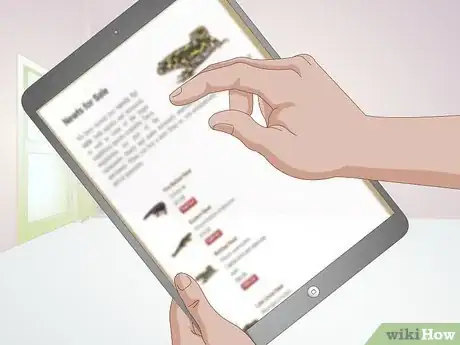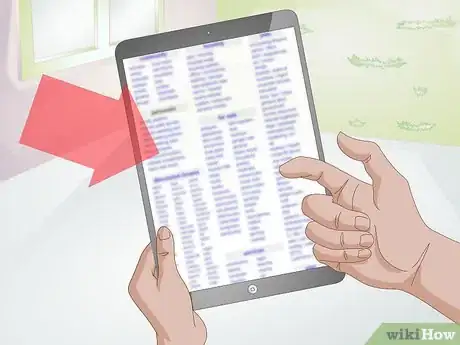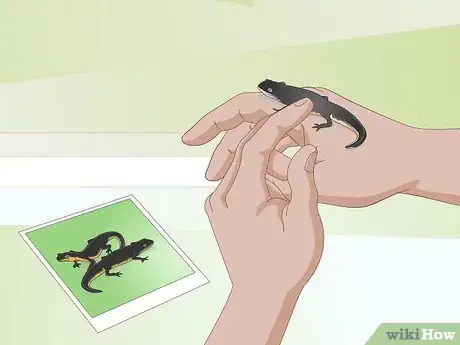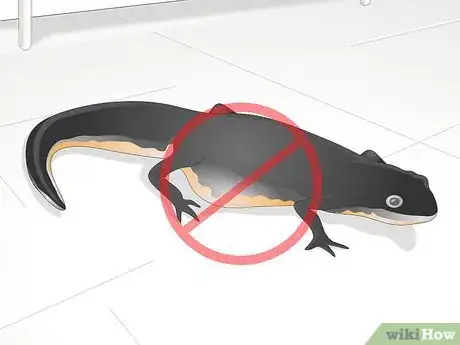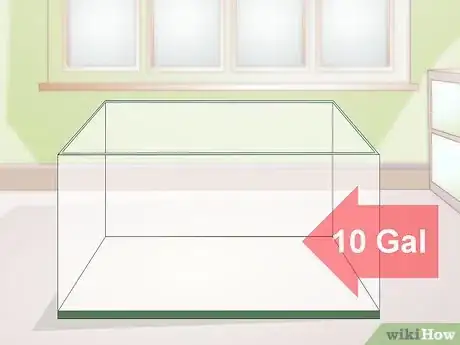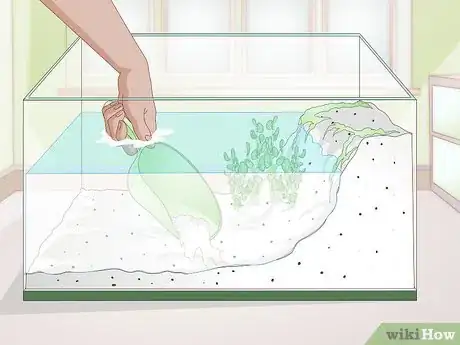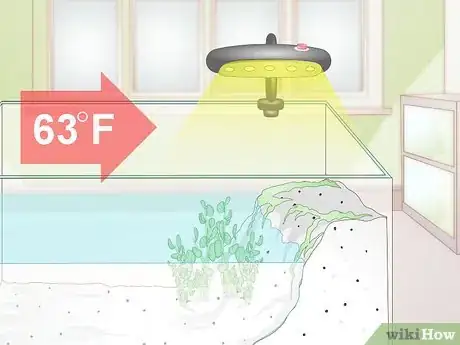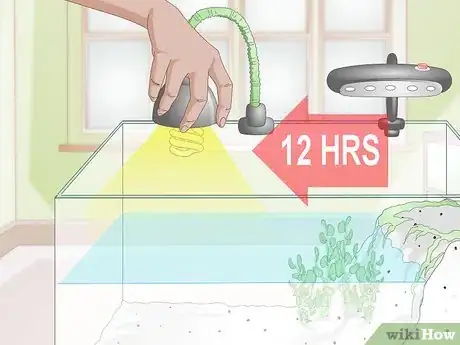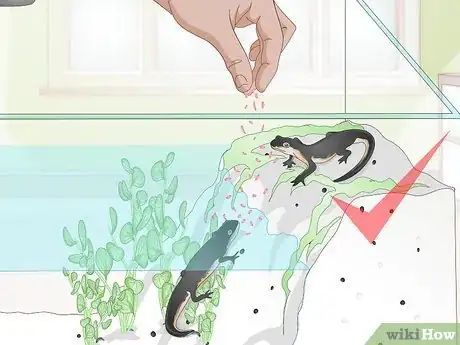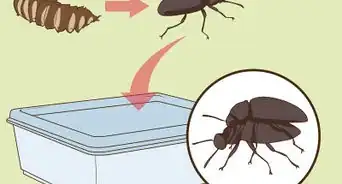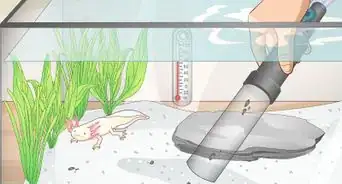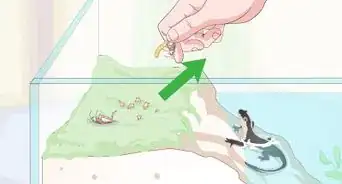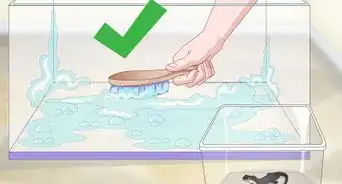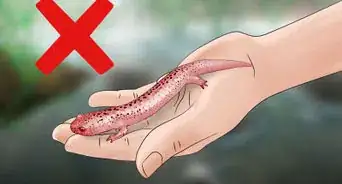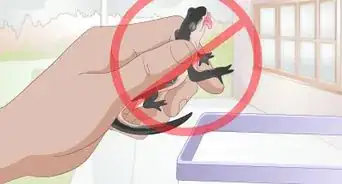This article was co-authored by Pippa Elliott, MRCVS. Dr. Elliott, BVMS, MRCVS is a veterinarian with over 30 years of experience in veterinary surgery and companion animal practice. She graduated from the University of Glasgow in 1987 with a degree in veterinary medicine and surgery. She has worked at the same animal clinic in her hometown for over 20 years.
This article has been viewed 31,600 times.
Fire bellied newts are common and easy to care for amphibians that are often found in pet shops and available from a number of breeders. Choosing a good newt is important, though, to ensure you get a healthy and long-lived pet. Whether you choose the slightly larger Japanese fire bellied newt or the smaller, smoother Chinese fire bellied newt, finding the right pet from the right store will help ensure you get the most out of your new pet.
Steps
Finding a Pet Shop
-
1Visit a pet store. While there are specialty stores for amphibians in some areas, many standard pet stores carry fire bellied newts. Call around to local pet shops to see if they offer newts for sale.
- Compare prices at multiple shops. You will pay a higher price for newts from a more reputable source, but regardless you probably do not need to spend more than $30 for your newt.
- Ask the pet shop, “How do you get your newts?” You want the store to know where your newt is from so that you can look into the supplier’s background and reputation. Newts live 6-10 years. If you find through reviews that your pet store sells newts that have a reputation for shorter lives, look elsewhere.
-
2Check out online stores. A number of places sell fire bellied newts through online shops. Look for a shop with humane shipping policies and guaranteed arrival.
- Check the online provider’s shipping policy. Make sure they use a lined box that is especially made for shipping reptiles, as well as heating or cooling packs to ensure the newt’s safety.
- Check to ensure that your provider will overnight or next-day ship the newt. Slower shipping may cause undue stress on the newts, impacting their health. Newts left too long without care may also die.
- If shipping policy is not specified on the site, call or email the provider to ask, “How do you ship your newts?” Do not buy from a provider that does not use proper shipping equipment, or that will not ship overnight.
Advertisement -
3Look in local pet advertisements. Consider finding a seller through advertising amphibian magazines or local newspapers. You may also be able to connect with local sellers through community posting sites such as Craigslist.
- Consider using local advertising as a means to rescue newts that are no longer wanted by their current owners.
- Check with current owners to see if they are willing to include the newt habitat and care equipment for an additional fee. This is often an easy way to get a full habitat at a good price.
Picking Your Newt
-
1Look for healthy skin. If you are buying a newt online, ask for pictures and written verification of the newt’s condition. Otherwise, inspect the newt for:
- A bright orange underbelly
- No visible cuts or abrasions on the skin
- No fungi or films growing on the newt’s skin
- No bubbling or bloating under the surface of the skin
-
2Check for healthy eyes. Cloudy eyes can be a sign of a sick newt. A healthy newt should have clear eyes that are black-brown in color.
- Clouding and discoloration in the eyes are signs of a sick newt. Do not purchase a newt with clouded eyes, and return any that are shipped with signs of illness.
-
3Find a larger newt. You want a newt that is well-fed from the beginning. Avoid small, lethargic newts, as they may be at greater risk of disease and early death.
- The average Chinese fire bellied newt is 2-4 inches long as an adult, and should look thick with its belly almost touching the floor.[1]
- The average Japanese fire bellied newt can reach 4-6 inches as an adult, though young newts may be as small as 2 inches. Japanese newts are more slender but should still be as thick by their hind legs as they are near their head.[2]
-
4Look for behavioral signs of illness. You may notice signs of illness at the pet store, or during the first few days of having a newt. Talk to the pet store about their return policy to see if it covers animals that show signs of illness soon after purchase.[3]
- Rapid weight loss, distressed breathing, lethargy, diarrhea, a bloated abdomen, and poor balance are all signs of illness in newts.
Setting Up Your Newt
-
1Find a tank. Your newt is going to need a habitat as soon as it arrives. Use a glass or acrylic tank as a terrarium. Ten gallons is the minimum size you need for one newt. For more newts, you will need more space.
- 1-2 newts: 10 gallon (37.9 L)
- 3-5 newts: 20 gallon (75.7 L)
-
2Get a good substrate. Newts prefer a mostly aquatic habitat, with a small land area. Try smooth slate or gravel for the water area, and a land area with a moss or mulch-type soil.
- Plant the land area with decorative plants that have large, broad leaves, as well as stacked rocks for basking.
- Fire bellied newts often appreciate underwater vegetation, as well.
-
3Set up climate control. Newts need a consistent climate of 58-68°F or 14-20°C. Letting a newt get too hot or too cold could be damaging to its health.
- Use heat lamps in cold climates to keep your newts warm.
- If your newt habitat is getting too warm, air conditioning is often the best option. If that is not available, some newt owners have successfully cooled their pets using fans above the tank, or ice packs against the outer walls of the habitat.
-
4Provide good lighting. Newts need 10-12 hours of full spectrum UVA lighting a day. Purchase lamps and proper bulbs that fit over the edge of your terrarium.
- You may be able to provide proper lighting and heating with the same bulb. Check packaging to see if your heat bulbs also offer UV.
-
5Feed your newt. Purchase food at the same time as purchasing your newt. Live and packaged foods both provide good nutrition for your newt if used properly.[4]
- Frozen mosquito larvae, canned snails, and freeze-dried shrimp are all regular staples in a domestic newt diet.
- Adding live food, such as blackworms, bloodworms, earthworms, and crickets helps keep your newt’s diet balanced while hunting them keeps your newt active.
Warnings
- Newts from big-box style pet stores may be more prone to illness and early death than those from specialty shops or breeders.⧼thumbs_response⧽
- Do not handle a newt for very long. They may cause irritation to your skin, and the oils in your skin may harm your newt. Always wear latex gloves when handling.⧼thumbs_response⧽
References
- ↑ http://www.reptilesmagazine.com/Frog-Amphibian-Species/Chinese-Fire-bellied-Newt/
- ↑ http://www.reptilesmagazine.com/Care-Sheets/Japanese-Fire-Bellied-Newt-Care-Sheet/
- ↑ http://www.petco.com/content/petco/PetcoStore/en_US/pet-services/resource-center/caresheets/salamanders-and-newts.html#
- ↑ http://blogs.thatpetplace.com/thatreptileblog/2012/02/21/newts-as-pets-an-introduction-to-their-care-and-feeding/#.V-hZUPkrKM8
About This Article
To buy a fire belly newt, look for signs that the newt is healthy, including an orange underbelly, and no cuts or fungal growth on the skin. Since cloudy eyes are a sign of a sick newt, check if its eyes are a clear brown or black color. If you’re selecting a newt from a group, choose one that’s larger, since smaller, poorly fed newts can be at risk of disease and early death. Before making a purchase, look for physical signs of poor health, such as a bloated belly, difficulty breathing, or lethargy. Once you’ve made your decision, purchase a tank for the newt, which should contain mostly water with a dry area made of moss or mulch. For tips from our Veterinary co-author, including how to provide the appropriate lighting for your newt, read on!

